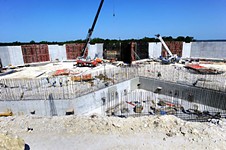The Genius of the Crowd ... Source
Austin programmers look to create a public redesign of the city's website
By Wells Dunbar, Fri., June 5, 2009

We describe websites as "portals" – windows into worlds where we can do any number of things: read, write, buy, sell, vent, connect with old friends, new acquaintances, or "casual encounters." But for years now, the only thing welcomed by the official city of Austin website has been bedlam. The only process more oblique than navigating through its counterintuitive alleyways has been the on-off, stop-start nature of attempts to redevelop the site.
As described by the city itself, the website (www.ci.austin.tx.us, or the less typographically challenging www.cityofaustin.org) went online in 1995 "as one of the few municipal government sites in the nation." From 1997 to 2007, it grew in page views from 189,000 to 4.5 million a month, and this growth in popularity mirrored its rise in public consciousness. At first, no one but the most earnest policy wonks paid it much mind, and the white-bread style and pedestrian inefficiency of the site was hardly noticed. But as time went on, the potluck content and bureaucratic design began to receive more negative notice; with the rise of blog-fueled, online politics, more Austinites began to consider the site as either a facilitator or an impediment to public engagement in city affairs.
In 2006, the Save Our Springs Alliance and the Austin ACLU put Proposition 1 – billed as the Open Government Online City Charter amendment – on the May ballot, along with a separate, development-related proposition, together touted as the "Clean Water/Clean Government" propositions. In combination, the propositions were designed as a one-two punch to simultaneously slow new development and in theory to keep a public eye – or as many argued at the time, a punitively intrusive eye – on City Council members' activities and deliberations. Following a fairly polarized campaign, both propositions lost by substantial margins. But the spirited public discussion, especially of public information issues, resulted in promises from council members (who had opposed both propositions) of greater online transparency.
But it was more than a year later, in November 2007, when council finally voted for a complete Web redesign. (The last redesign of the site occurred in 2002, well before the sticky, mobile, social wave of Web 2.0.) This led to the Austin Government Online initiative, or Austin GO, the centerpiece of which was a survey of approximately 2,000 Austinites that confirmed many of the inefficiency problems familiar to website users: For instance, almost 30% of respondents found it "difficult or very difficult" to find information they were looking for, and more than 60% said they couldn't find pages that they in fact knew were hosted on the site (a nuisance all too familiar to City Hall reporters).
This March, the city looked prepared to award a contract for the long-delayed redesign, until a welter of online outrage crashed the plans. City staff had recommended Santa Clara, Calif.-based Cignex Technologies be awarded the contract, but widespread public backlash considered the "outsourcing" an insult to and embarrassment for the local tech community and industry. As the Austin GO report itself declares, "No city in the nation boasts a more technologically adept and creative group of residents than Austin."
Dev Camp Austin

Contract protesters were doing more than Tweeting into the wind. Online, they were organizing and strategizing using the same free, crowdsourced set of tools they hoped to see the city appropriate.
"I'm just a guy trying to get a lot of people to work together," says William Hurley, known in tech development circles simply as "whurley." While in his day job he works for IT infrastructure giant BMC Software, he's regarded in the public tech realm as a guru of "open source" – the technology movement advocating the public availability of programming source codes, so that any programmer with a great idea can develop and share his or her own applications. Recently, he's set up "dev camps" – development camps, in programming parlance – so programmers across the globe can collaborate on coding apps for the iPhone and for Palm's still unreleased Pre smart phone. His title at BMC is chief architect of open-source strategy.
"I came into this at the point I heard all the controversy," says Hurley, referring to the ubiquitous Tweets, blog entries, and Facebook updates aligned against the city staff contract recommendation. "And so the original concept was really simple: Why don't we take a portion of the budget and reinvest it in people that had been laid off – lost their jobs, through no fault of their own, that have this talent in the community – add that to a bunch of volunteer help, and then take the money we save and reinvest it back into vital services?" Citing the city's budget shortfalls, currently anticipated at $43 million failing a property-tax increase, Hurley says, "I'd rather lifesaving services get money over us having a cool website, when we have so much talent and so many people that would be willing to do the work – there's just no excuse not to utilize them as a resource."
Hurley envisions this human resource utilization taking place through "crowdsourcing" – a form of à la carte programming through which dozens if not hundreds of people can break down and share one large project by farming out separate aspects of the whole to be worked on independently and then recombined. As the Internet's reach and connectivity has enabled people to collaborate across previously unfeasible distances, crowdsourcing is coming into its own. "I have a very easy system of managing these types of large projects," says Hurley. "With preDevCamp, these people are going to develop 300 to 500 applications in this infrastructure that I've set up, and they're gonna do that in a weekend. And they're never going to see each other face to face. So doing projects like this is very manageable." (According to its website, Hurley has since stepped down from the preDevCamp organization team.)
To kick-start the redesign process, Hurley initiated OpenAustin, a website where users can vote ideas for the city website up or down and submit their own. They range from the pedestrian (the currently top-rated suggestion is to pay Austin Energy bills online, followed by a system to list road closures across the city) to transparency-related (being able to track applications for city contracts, putting City Council meetings and video online faster) to the more arcane techy ("machine-readable data feeds" for all city info: crime, restaurant health inspections, etc.; and similarly, publishing every piece of city data as RSS feeds).
Hurley acknowledges OpenAustin is currently in the idea-generation stage. The final form of OpenAustin's assistance in the redesign is still very nebulous – and of course, entirely dependent on the city's response. Still, Hurley foresees several ways it could take place. "Maybe we don't take all the RFPs [requests for proposals] when we do it, and maybe we don't take everything and outsource it to the community," he says. But he thinks OpenAustin could "help coordinate the community effort" by conceiving the redesign so volunteers could create mash-ups of applications: for example, overlaying a map of all the city's bike routes with a map of free Wi-Fi hot spots or early voting locations.
"I saw an opportunity to say, 'Hey, maybe there's an alternative way to look at this that will get it to you faster, involve the community more, and build better ties between the community and the city,'" says Hurley. "And also allow you to free up some of your vital resources to do some really, really great stuff in other areas of the site. Imagine if [the website developers] were not tasked with 'OK, we've got 30,000 blocks of data we gotta move,' and they could be like: 'OK, we're just gonna manage that process. Here's the resources, and with the free time we have, now we're going to do some really cool stuff.'" Instead of the city thinking about the redesign project as its in-house coders and an outsourced contractor, it should "start thinking about it as potentially all that, plus thousands of people that are in the city that could participate in this process."
Change the Language
In spearheading awareness of the redesign process, OpenAustin is already partially responsible for a victory: The city is set to issue a new RFP that's far friendlier to local programmers. "Woot!" as they say.

"The big issue from my perspective was, from the very start, each one of these RFPs was asking for a proposal based on a prescribed solution," says Doug Matthews, the city of Austin's chief communications director. That solution was Plone, the content management system that currently powers the city intranet, the in-house end of the city website; the last five RFPs issued involving the city website – all since withdrawn – required that applicants use the Plone framework. "The difficulty with that," Matthews continues, "is it's kinda like bidding out a construction contract and putting in the construction contract that you have to use Caterpillar construction vehicles. There's plenty of capable construction companies out there that could get the work done; we shouldn't be telling them what tools they have to use to get the work done. So it really limited the ability of the tech community at large to look at what we have in terms of infrastructure." (Hurley concurs, saying "the fact that you would be beholden to any one platform shows from the beginning that it's maybe not the best information architecture.")
Calling Plone unproven and "really not readily available in terms of a skill set in this area, in general" (hence California-based Cignex's winning bid), Matthews is prepared to withdraw the most recent RFP and issue a new one which doesn't name a specific program. "By opening this back up and not prescribing the particular technology, just intuitively, that's going to open it up to a lot more competition." With the new RFP being worked on already, Matthews' team will make the case for the reboot before City Council June 18; the revised RFP is on track to be issued in July. Still, Matthews notes that the feedback the city collected through the Austin GO process will still be incorporated: "The fact that we're reworking the RFP doesn't mean that we're discarding all the valuable input that we've collected along the way."

The city website presents some unique challenges, according to Gail Roper, the city's chief information officer. (As CIO, Roper says, she's "the architect that builds the hotel," and Matthews is "the marketing salesperson that brings people to the hotel. Pretty corny, I know," she laughs.) "Our challenge here in Austin is we have to put a front end – I say lipstick – on this thing and make it look good. But we also have to make sure it's functional, and all the data that comes out of any Web portal comes from your back-end systems. And the back-end systems here in Austin are very disparate in terms of commonality and accessibility," including systems overseeing financial management, human resources, utility billing, and more. "So we have to make sure that this thing works. We're gonna make sure we don't put lipstick on a pig – that we have a fully functioning website that works for the city. A lot of folks outside of the city organization don't know a lot about those back-end systems," she says, noting she is "just learning" about several of them herself.
As for OpenAustin: "What they're doing right now is very valuable," Matthews says. "They've got a site up right now that is recharging the examination of what people want to see. I think that's fantastic; that's information that I value. As far as doing a fully-functional website using that crowdsource model, with the sheer scope and complexity of what we're talking about with the city of Austin, I don't think that you can do it whole hog." However, he says, "it very well may be part of the overall solution. And we're going to work into the RFP some options where there can be some local participation, maybe even on an individual level." While acknowledging it's a challenge, Roper says: "I don't think it's undoable. I just think it's a shift. It's a shift from the way we've done things in the past."
Indeed, it may be serendipitous that the redesign, bandied about for more than three years now, is now coming to a head. That delay can be attributed in part to institutional city inertia but also to a turnover in staffing. Roper and Matthews both started with the city in February. Roper took over from former CIO Pete Collins, who resigned in August 2008 while the city investigated unspecified allegations that he used city resources on a personal project. His departure was blamed around City Hall for slowing the redesign process – but now with the city mulling several exciting options, was that in retrospect a good thing? "Think about it," says Roper. Since the city first proposed the redesign, "the CIO changed, the PIO [public information officer] changed, and I believe the city manager as well."
Connect & Develop
Back at OpenAustin, Hurley says he's been "especially and exceptionally happy" with the city response. As for the criticisms of a crowdsourced, open-source redesign – largely security- and execution-related – he has some answers. He starts by pointing to Procter & Gamble's "connect and develop" program, where instead of developing new products solely through research and development, the company now strives to get 50% of its new products from outside the company. "Half of our new products ... would come from our own labs, and half would come through them," wrote two P&G executives in the Harvard Business Review. This is the process Berkeley professor Henry Chesbrough deemed open innovation, taking advantage of innovation wherever it may be by licensing ideas or patents from outside your organization. "Now when you look at that," says Hurley, "and think about one of the largest corporations on the planet – and arguably a corporation by default is somewhat secretive with and sensitive to its intellectual property – if they can do it, I can't imagine what's going to be on the city website, that we really can't do the whole thing this way." He acknowledges the project is counterintuitive for the city, but he says the defining characteristic of all his work is "to help mitigate the risk of working with very large-scale communities."
Part of mitigating the risk includes keeping the project secure. But Hurley says "there is a lot of misconception about security in open source and open innovation" here, namely that any programmer-come-lately could get the keys to the city website. "The illusion is that everyone has control or will easily be able to gain control over a project," he continues, and cites the ubiquitous Apache Web server, one of the world's most popular open-source programs. "When you look at large-scale projects like Apache, you find that out of millions of users, only a few thousand could actually be considered contributors. Of those contributors, only a few hundred could be considered developers. Of those fewer hundred, only a handful of people actually have the ability to take changes from the community and commit them to the base code. So as you can see, even though contributions will be taken from everyone, not everyone will have the ability to commit code to the city's website. In fact, this may be something the city wants to keep firmly in the hands of their Web team even while working with the community, and that's absolutely fine."
It's clear Hurley envisions something more than 100 code-monkeys banging away on Cheetos-stained keyboards. "I understand the legalities; I understand the intellectual copyrights; I understand the schedule problems and the cost problems and the dependencies. And like I said, I just want to help the city." Hurley is anxious to see the RFP; he says if the city doesn't want to work with OpenAustin as it currently exists, he plans on forming a nonprofit group to bid for the contract.
The New Utility
Whatever final form the website redesign takes, it will certainly be an improvement not only over the existing portal but also over what the city was mulling just a few months ago. The balance the city faces is in designing a site that can satisfy not only the tech-savvy crowds of OpenAustin, who have vastly invigorated public discussion of the site, but also the average visitor looking to contact her council member. (As Web tools like social networking, blogging, and the like become more ubiquitous, this gap is already shrinking.) Another component that shouldn't be overlooked is the original impetus behind the redesign, the push for greater transparency and accountability; the city could get the slickest website in Cyberspace, resplendent with Web 2.0 doodads, but if it isn't fed more information on permitting, development, and budgeting, it would still be an epic failure.
Nevertheless, the project has not only the potential to do right by the city but perhaps the whole country. Hurley and OpenAustin are examining the possibility of taking a program like Plone (despite its vilification, Plone is, indeed, open source, although Hurley says there are better open alternatives), "forking it, and creating a project called City Server, which would be something that would be specifically designed for cities. So that Austin could be the world leader and also offer it as open source to any other cities and create a community of volunteers across cities. ... What do cities have in common, all over the world? They have wastewater services, electrical grids, infrastructure components. So if information nowadays is just as vital as our EMS, as our water, all of that ... then why don't cities have some common methodologies for doing that same thing and for involving communities? And that's where this new project is starting to come up."
The Next Step
City Web staff will go before City Council June 18 to make the case for rebooting the redesign process. A revised request for proposal will be issued in July.
Got something to say on the subject? Send a letter to the editor.









